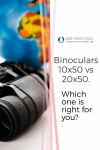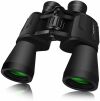
INTRODUCTION
Binoculars are
magnifying optical instruments that are extremely common in the world around us
today. These handheld devices are used to help us have a closer look at distant
objects. Whether it be hunting, bird watching, urban exploring, or even
theatre, binoculars play a key role in optimizing user experience. Two
telescopes mounted together, binoculars not only give us a magnified image but
also create depth which explains their use over regular
telescopes.
**Buying the right pair of binoculars can be tricky. With so many options in the market, one can easily get confused and end up buying an
unsuitable pair. Not to worry! We will dissect and compare two important types
of binoculars, the 10x50 and the 20x50. Welcome to our complete and comprehensive
guide!**
IMAGE STABILITY
Holding binoculars while trying to focus on a far-away object is not easy. The shakiness of the hand, and on the micro-level the beating of the heart, causes the binoculars to shake too. This can be a problem when one is trying to study close detail such as the feathers on the back of a bird or the pattern of a deer’s fur.
But how does the shakiness cause a problem? When the binoculars magnify the image, they tend to magnify the shake of the hand too. So while a 10x pair would give you a 10 times enlarged image, it would also amplify minor hand movements by 10 times. Similarly, as 20x binoculars would present a 20 times magnified view, they would also increase the shakiness of the hand by 20 folds!
Here is a test you can use to compare the image stability of 10x and 20x binoculars!
Place a currency note on a wall and stand almost 30 feet away. Now try to read the inscriptions on the note using a pair of 10x binoculars. Next, do the same but with a 20x binocular pair.
Notice the difference? The 20x pair makes it almost impossible to read even though it is highly magnified. Why is that? Because minor movements have been amplified 20 times, unlike the 10x binoculars that only amplify minor movements by 10 times.
Even though 20x binoculars offer more magnification than 10x, they also have lesser image stability. Hence it is much more difficult to use the 20x pair without a tripod or stand. One does not face the same problem with the 10x pair. The bigger the image doesn’t always mean clearer the image. If you can’t hold 20x binoculars steady, there is no use for higher magnification and hence 10x would be a better fit for you.
PRO-TIP
If a tripod is unavailable, rest your binoculars on a stable surface to stabilize the image e.g. you can rest it against the branch of a tree while spotting a deer in a forest.
FIELD OF VIEW
As per the Oxford dictionary, the ‘Field of View’ is the total amount of space that you can see from a particular point without moving you. In the context of binoculars, it is the amount of space your pair covers. How is the field of view linked to the magnification of binoculars? the higher the magnification, the closer and more focused the image will be. This will result in less area covered, but a more magnified image. The lesser the magnification, the more area will be covered as the image will be not as focused. Hence the 10x binoculars will cover more area than the 20x binoculars.
Let’s look at a real life example to understand this better:
Imagine you are in a forest trying to spot a rabbit. Speaking from common sense, a wider field of view will make it easier for you to spot a rabbit as more area will be covered by the binoculars. It will be easier to see the rabbit hopping around the bushes and crawling on the floor of the forest.
But what if you have a different goal? Instead of just simply spotting the rabbit, do you want to observe the pattern on its back? In that case, higher magnification and a smaller field of view would be more suitable as it would give you a much more focused image
To sum it all up,
a 10x pair would provide you with a larger field of view but lower
magnification while a 20x pair would have a lower field of view but greater
magnification.
We recommend these 10x50 binoculars:
Vortex Optics 10x50 Prism Binoculars
Portable, lightweight, and trendy! The perfect gift for your explorer friends.
LOW LIGHT PERFORMANCE
The human eye is a wonder of nature. The way our eyes adapt to low or high quantities of light is by reducing or increasing the diameter of the pupil. During low light conditions, the pupil expands to the diameter of 7mm to let more light in resulting in a brighter image.
In sunlight or other high light conditions, your pupil has the capacity to contract and shrink its diameter to 2mm resulting in less light entering your eyes. But sadly, our binoculars are not capable of doing this to adapt to varying light conditions. The light-gathering ability of a pair of binoculars does not change, meanwhile, the amount of light varies through the day. Hence, it is very important to know all the facts and buy a pair that suits your needs. Here the binoculars’ exit pupil comes in.
Hold the pair of binoculars a foot from your face and peep in, you will be able to spot a small circle in the center of each eye piece. This is called the exit pupil and is essential to the brightness of the image you see. The closer the size of the exit pupil is to the size of the pupil of your eyes, the brighter your image will be.
PRO-TIP
CALCULATING THE EXIT PUPIL
The exit pupil of a pair of binoculars can be found by dividing the magnification (10x or 20x) with the diameter of the lens in (50 mm). Hence the exit pupil of the 10x50 binoculars will be 50/10 = 5mm and that of the 20x50 binoculars will be 50/20 = 2.5 mm.
During premium hunting times of dawn and dusk when your pupil is dilated to 5-7mm, the 10x50 binoculars would be the choice to go with because of their exit pupil (that is of 5mm) being comparable with the pupil to your eye. This will result in a bright and clear image.
In these conditions, 20x50 binoculars would not be a smart choice due to a smaller exit pupil. However during high light conditions e.g. when the sun is completely out, the 20x50 would be a better choice as its exit pupil of 2.5mm is more comparable to the human pupil of 2mm.
EYE RELIEF
Eye relief of 16mm and above is recommended for users with glasses!
If you are a person who does not wear glasses, you do not need to worry about this at all. However if you or anyone in your family that might end up using the binoculars wears glasses on the regular, read carefully. Almost 60% of all human population use some type of vision correcting device, majority of them using glasses.
How does wearing glasses affect your binoculars experience? If you wear glasses and have used a pair of binoculars before, you must have noticed how your glasses tend to prevent you from seeing the full image the binoculars have to offer.
Eye relief can be defined as the distance between your eye and the eyepiece that will help you observe a full and clear image via the binoculars. If you do not wear glasses, less eye relief will not bother you at all.
However, if you are a person who wears glasses regularly, less eye relief can be a major problem. You would need to get a pair of binoculars with a bigger eye relief so that it can accommodate your glasses too. Unusually, the higher the magnification the lower the eye relief. Most 20x binoculars will have a lower eye relief than most 10x binoculars. However, this is not a set rule. You can find 20x binoculars with suitable eye relief too if you look hard enough!
Check out these 20x50 binoculars that we highly recommend:
CONCLUSION
If you’re looking for a simple answer as to which pair of binoculars, the 10x50 or the 20x50, is better then you would be disappointed to know that it is not that simple!
No pair is objectively better than the other, but each pair caters to different uses. We have described detailed characteristics of both types, now it is up to you to decide what fits your and your family’s needs best. While you are at it, check out our article on how to draw a rabbit!

By David A. Swanson
Bird Watching USA
My name is David and I'm the the founder of Bird Watching USA! I started Bird Watching with My father-in-law many years ago, and I've become an addict to watching these beautiful creatures. I've learnt so much over about bird watching over the years that I want to share with the world everything I know about them!

David A. Swanson
Bird Watching USA
My name is David and I'm the the founder of Bird Watching USA! I started Bird Watching with My father-in-law many years ago, and I've become an addict to watching these beautiful creatures. I've learnt so much over about bird watching over the years that I want to share with the world everything I know about them!










